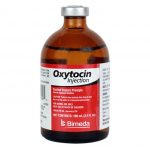Oxytocin Use to Support Pregnancy Instead of Regumate (Altrenogest)?
It seems initially counter-intuitive to consider oxytocin use to support pregnancy instead of Regumate or other altrenogest treatments which are commonly used to potentially increase – or at least maintain – progestin levels during early pregnancy in the mare. Oxytocin causes uterine contractions and will expel the pregnancy, right? Well, it’s not that easy!
 It has been shown previously that treatment of mares with oxytocin at certain levels and points in diestrus can maintain the corpus luteum beyond the stage where it would normally be lysed (functionally destroyed) by the naturally-occurring prostaglandin release towards the end of diestrus. The hypothesis for this effect is that the exogenous oxytocin inhibits the natural increase in endometrial oxytocin receptor concentration at the end of diestrus that normally leads to oxytocin-induced PGF2α secretion, which in turn would result in luteolysis [1]. The question then is can oxytocin treatment during early pregnancy have the same effect and can one use oxytocin instead of Regumate (or other altrenogest supplementation) to assist in pregnancy maintenance? Furthermore, what effect will the oxytocin have – if any – on embryo retention?
It has been shown previously that treatment of mares with oxytocin at certain levels and points in diestrus can maintain the corpus luteum beyond the stage where it would normally be lysed (functionally destroyed) by the naturally-occurring prostaglandin release towards the end of diestrus. The hypothesis for this effect is that the exogenous oxytocin inhibits the natural increase in endometrial oxytocin receptor concentration at the end of diestrus that normally leads to oxytocin-induced PGF2α secretion, which in turn would result in luteolysis [1]. The question then is can oxytocin treatment during early pregnancy have the same effect and can one use oxytocin instead of Regumate (or other altrenogest supplementation) to assist in pregnancy maintenance? Furthermore, what effect will the oxytocin have – if any – on embryo retention?
The use of Regumate and other progestin supplementations are not without a downside. We discuss these in our article which asks “Does My Mare Need Regumate?” In view of the various risks, and the work performed by Vanderwall et al. McNaughten and Wallace explored the possibility of oxytocin use to support pregnancy instead of altrenogest, to assist with elevating progestin levels in a more natural manner.
39 mares aged between 5 and 19 years were managed over 55 estrous cycles. Two groups were established – one which received once daily treatments of 60 IU of oxytocin on days 7-14 via intramuscular injection; and the control group, which did not receive anything. The mares were checked for pregnancy by ultrasound on day 14 following ovulation. Those mares which were not pregnant were treated with prostaglandin on day 16 and returned to the study for a repeat of the protocol. Pregnant mares were reevaluated for pregnancy status on days 28 and 45, again using ultrasound.
There were no statistical differences found between the two groups of mares relative to pregnancy rates at any stage, or progesterone levels. Median progesterone concentrations for the treated group were 6.9 and 7.0 ng/ml for the control.
Our own interpretation of these results, notwithstanding the author’s observation that “In this population of mares, oxytocin administration during mid-diestrus in early pregnancy did not induce a negative effect on pregnancy rate nor a positive effect on progesterone concentration”, is that there may be a potential benefit. It is not clear if any of these mares might otherwise have had “low progesterone” levels, so although a beneficial effect was not clearly demonstrated, it cannot be ruled out. This is supported by the author’s further comment that “Further investigation in this area may reveal potential beneficial effects of oxytocin administration in early pregnancy.”
There are several areas of difficulty related to research targeting allegedly “low progesterone mares”. We comment upon reasons for this in greater detail in our article to which we linked above, but several of the issues are that we don’t actually know what a “low level” is (while 4 ng/ml is often offered as a suitable level, many mares maintain pregnancies with levels far below that); “low levels” may also be transient; and it is almost impossible to create a controlled experiment involving naturally “low” mares, as there may be no identified, or inconsistent causes. That all of the mares in this research showed levels well in excess of any hypothetical “low level” is an important point for consideration. The use of several days of oxytocin use to support pregnancy is considerably cheaper than months of Regumate, and additionally does not carry the risks related to either human or animal exposure. It will be interesting to see what further developments come from this research, either with clinical use of the protocol, or further research.
(McNaughten JW, Wallace RC. 2023. Effect of mid-diestrus oxytocin treatment on early pregnancy in the mare. JEVS 125:104776)
References:
1: Vanderwall DK, Rasmussen DM, Carnahan KG, Davis TL. 2012. Effect of Administration of Oxytocin During Diestrus on Corpus Luteum Function and Endometrial Oxytocin Receptor Concentration in Cycling Mares. JEVS 32;9:536-541.



